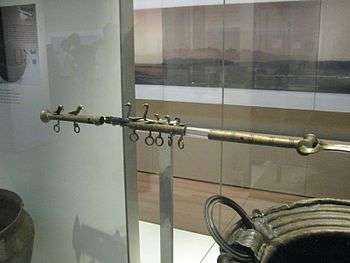Dunaverney flesh-hook
| Dunaverney flesh-hook | |
|---|---|
 Dunaverney flesh-hook | |
| Material | Bronze |
| Created |
late Bronze-age (1050 BC – 900 BC)[1] |
| Discovered | 1829, Garry Bog, Dunaverney, Co. Antrim |
| Present location | British Museum |
| Bronze Age |
| ↑ Chalcolithic |
|
Near East (c. 3300–1200 BC) South Asia (c. 3300–1200 BC) Europe (c. 3200–600 BC)
East Asia (c. 2000–300 BC) |
| ↓Iron Age |
|
The Dunaverney Flesh-Hook is a sophisticated prehistoric bronze artefact from Prehistoric Ireland, thought to be an item of ceremonial feasting gear, and a symbol of authority. It is believed it was used to remove chunks of meat from a stew in a large cauldron for serving. It dates to the Late Bronze Age, between 1050 and 900 BC. Since 1856, it has been in the British Museum in London.[2]
Description
Along the top of the flesh-hook are five birds, two large ones next to three smaller ones. At the bottom of the shaft, facing the family of five, are two birds. The group of two birds, presumably an adult pair, can be identified as corvids, perhaps ravens, the family of five as swans and cygnets. The two sets of birds seem to invoke opposites: birds of water versus birds of the air; white ranged against black, fecundity as opposed to death (implied by the predatory character of ravens). Perhaps, in the mind of the Bronze Age inhabitants, the two sets of birds denoted a fable of opposites between good and bad. The flesh-hook was originally linked by pieces of oak shaft, only one fragment of which remains extant.
Discovery
The Dunaverney Flesh-Hook was discovered in 1829 by workmen who were cutting turf at Dunaverney Bog to the north of Ballymoney, Co. Antrim, Northern Ireland. At the time of its discovery, the Dunaverney Flesh-Hook was unparalleled and for a long time many experts could not agree on its age and function. However, as more examples were found, not only in Ireland and Britain, but along the Atlantic seaboard of the European continent, it became clear from their style, technology and context that they belonged to the Bronze Age and were clearly important instruments used during ceremonial feasts. To this day, the representation of birds seen on the Dunaverney Flesh-Hook remains unique in north-west Europe.[3]
See also
Gallery
- The corvids at the end
- The waterbirds in the middle
- The hook
- The right-hand side of the flesh-hook (the cauldron is unrelated)
References
- ↑ "Bronze flesh-hook". The British Museum. 2010. Retrieved 29 June 2010.
- ↑ British Museum Collections
- ↑ "The Dunaverney and Little Thetford flesh-hooks: history, technology and their position within the later Bronze Age Atlantic zone feasting complex". Institut de l'information scientifique et technique due CNRS.